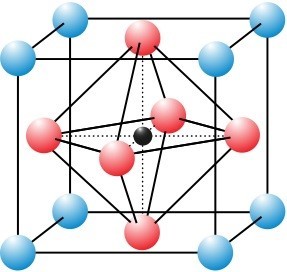Perovskite materials
A perovskite is any material with a crystal structure following the formula ABX3, which was first discovered as the mineral called perovskite, which consists of calcium titanium oxide (CaTiO3). Perovskites have a nearly cubic structure and the chemical formula is ABO3. Typically perovskite compounds have the chemical formula ABX3, where "A" and "B" represent cations and X is an anion bound to both. A large number of different elements can combine to form a perovskite structure. Using this compositional flexibility, scientists can design perovskite crystals with a variety of physical, optical, and electrical properties. Today, perovskite crystals are found in ultrasonic machines, memory chips and current solar cells.

Schematic diagram of perovskite crystal structure
Potential applications for perovskites are various, using in sensor and catalyst electrodes, some types of fuel cells, solar cells, lasers, storage devices, spintronics and so on.
Clean energy applications of perovskites
All photovoltaic solar cells rely on semiconductors—materials that sit between electrical insulators like glass and metal conductors like copper—to convert energy from light to electricity. Light from the sun excites electrons in the semiconductor material flow into the conducting electrodes and create an electrical current.
Silicon has been the main semiconductor material used in solar cells since the 1950s because its semiconductor properties closely match the spectrum of sunlight and are relatively abundant and stable. However, the large silicon crystals used in conventional solar panels require multi-step manufacturing processes that use large amounts of energy, that means the cost is more expensive. In the process of finding an alternative to silicon, scientists have exploited the tunability of perovskites to create semiconductors with properties similar to those of silicon. Perovskite solar cells can be manufactured using simple additive deposition techniques, at a fraction of the cost and energy. Due to the compositional flexibility of perovskites, they can also be tuned to perfectly match the solar spectrum.
In 2012, researchers discovered discovered for the first time how to use lead halide perovskites as light-absorbing layers to create stable thin-film perovskite solar cells with photon-to-electron conversion efficiencies exceeding 10%. Since then, the conversion efficiency of perovskite solar cells has skyrocketed, reaching a laboratory record of 25.2%. The researchers also combined perovskite solar cells with conventional silicon solar cells—the efficiency of these "perovskite-on-silicon" tandem cells is currently 29.1% (beyond the record of 27% for conventional silicon cells) and rising rapidly. With rapid improvements in cell efficiency, perovskite solar cells and perovskite tandem solar cells may soon become cheap, efficient alternatives to conventional silicon solar cells.
Related news
Recently, Dazheng Weina (Jiangsu) Technology Co., Ltd. (hereinafter referred to as "Dazheng Weina") successfully secured over 100 million yuan in its Series A3 funding round. Notably, the "Future Creation No. 3 Fund" from SPARX Asset Management Co., Ltd.—one of Japan's largest venture capital funds—led the investment, while funds under Guoxing Investment continued to increase their stake.
The 4th Perovskite Technology, Equipment, and Materials Forum 2025, hosted by Asia Chemical Consulting, was officially held in Suzhou from October 14 to 16.
The 2025 Global Perovskite Industry Development and Future Applications Forum, hosted by the perovskite factory and co-organized by Fina Optoelectronics and Qingdao Institute for Green Development, officially kicked off in Qingdao, Shandong, from September 24 to 26.








